Catholic Customs
 |
 |
 |
 |
 |
 |
 |
Ash Wednesday: The Start of Penance
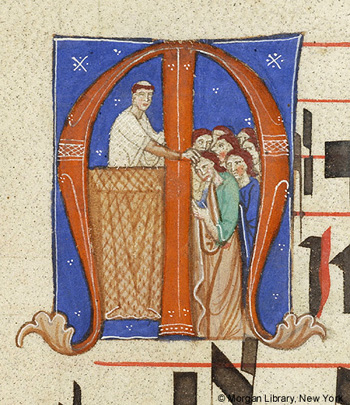
Receiving ashes to begin Lent
In southern Germany and Austria, bells tolled at midnight on Shrove Tuesday in cities and towns to sound the beginning of Lent. In the morning, the bells rang again in a mournful tone to announce the Ash Wednesday Mass and the distribution of ashes. (1)
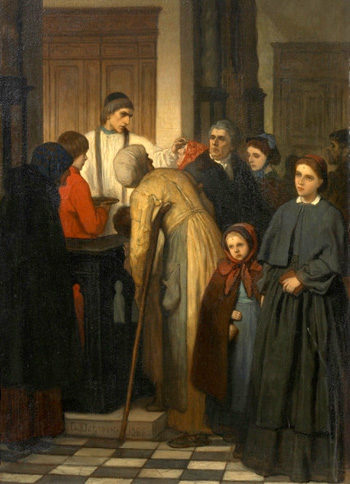
Old, young, healthy & sick receive their ashes in a church
After receiving the ashes, the people often walked in procession to another church to pray there before processing back to their parish church to assist at Mass. Some went barefoot during this procession in the spirit of penance. In the 12th century, there are records of the Pope himself processing barefoot followed by his Cardinals. (2)
The blessed ashes were such a cherished Sacramental that the faithful often found ways to bring them to the sick and infirm. Polish priests visited the houses of the sick and infirm to administer ashes to the homebound.
The faithful of Germany pressed their ash-marked foreheads against the heads of family members who were unable to go to church so that all could share in the blessings of the ashes.
Ash Wednesday brought preparations for Holy Week in many Northern European countries. The people collected pussy willow branches and placed them in vases of water in their houses so that they would bud on time for Palm Sunday.
These beautiful branches were used in place of palms in these countries for the Palm Sunday procession. They also served as a beautiful reminder of the approach of the joyous days of Easter and an encouragement for all to persevere in their Lenten penances.
Penitential processions
Penitential processions were a common sight in cities and villages throughout all of Lent. During Fridays and Wednesdays in the Middle Ages, the priests led a procession to a stational church while chanting the Litany of Saints in a sorrowful tone. When they arrived at the church the priests prostrated and said the Prayers and Suffrages. After these solemn supplications, the Mass began. (3) In monasteries, the monks processed barefoot in the cloister. (4)
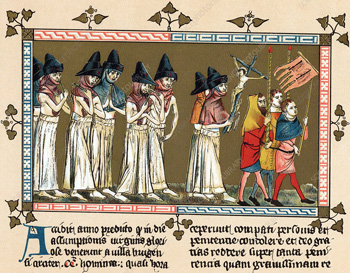
A penitencial procession in Tournai, 1349
In the Portuguese town of Freixo de Espada à Cinta, a somber "Procession of Seven Steps" takes place at midnight on the seven Fridays between Carnival and Easter Sunday. At the chosen hour, 12 chimes ring from the church tower signaling that all the lights in the town must be extinguished, leaving everything in complete darkness.
Three men wearing black robes begin the procession at the main church. Two men lead the procession dragging chains attached to their feet. They are followed by a man called the "Old Woman" who walks slowly and hunched over carrying a flask of wine and a cane in one hand and a candle in the other
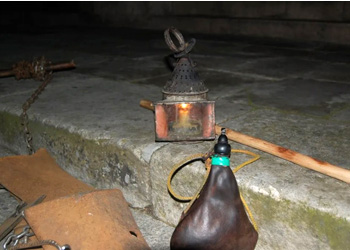
The flask of wine & light carried by the 'Old Woman' in the Procession of Seven Steps
The procession stops at chosen chapels where men in black robes belonging to the confraternity of the "Order of Souls" sing solemn hymns in Portuguese and Latin asking God to pardon the souls in Purgatory. The procession ends in the church where it began. (5)
The Portuguese people are also reminded of their duty to pray for the dead during Lent by a solemn call made late in the night by groups of men and women who walk through the villages and cities chanting the Dies Irae or traditional dirges calling all to rise from their beds and pray. Miranda do Douro, the traditional song for this occasion, has stirring lyrics:
Awake, sinners, awake and sleep no longer;
Remember the souls of your fathers who burn in flames
Who left their property to you who remember them no more. (6)
Almsgiving & special devotions
The poor souls in Purgatory were not the only souls who benefited from the charitable practices of Lent; the poor living on this earth were also remembered by good Catholics. Kings and nobles throughout Christendom deprived themselves of their usual delicacies in order to give more alms to the poor.
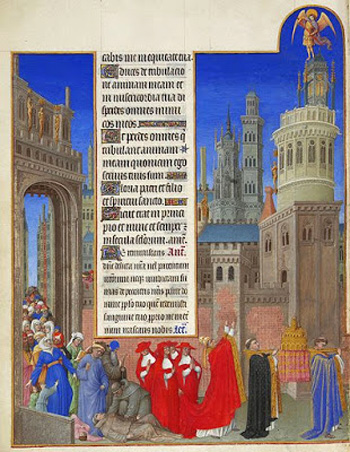
A Lenten procession led
by Pope St. Gregory the Great in Rome
The Stations of the Cross, the most traditional devotion, were performed with much solemnity in Cathedrals and parish churches. In addition to the weekly Stations of the Cross, parish or missionary priests often gave retreats for parishioners during Lent delivering sermons calling for penance and reform of life. At the end of the retreat, the people went to Confession and received their Communion.
In Rome, the stational church at which Mass was said changed each day. The zealous faithful of Rome strewed the street of the day's station with sand and boxwood eagerly awaiting the solemn procession that led the Pope and his entourage to the church. Beggars lined the streets and the church steps to ask for alms, trusting in the people's charity during this Holy Season. (7)
On each evening of Lent in Greece, a man known as the Toumbakaris walked through the streets beating a drum to call all to the Lenten vigil (an all night vigil in the church attended by many of the faithful). (8)
The Poles sang special Lenten hymns all through Lent to show their deep compassion for Our Savior. The most solemn of these were turned into a ceremony known as Gorzkie Zale (Lenten Lamentations) held at the church on Sunday or Friday evenings. These moving hymns, cherished even in our day, reflect the natural melancholy and poetry of the Polish soul. (9)

A cock crowing, from a medieval manuscript
The presence of the Cock Crower only during the season of Lent gave the alarming crowing more significance as it announced to the impenitent sinner his need for penance. T.F.Thiselton-Dyer describes this significance:
"Had the practice continued throughout the year, the impenitent would become as habituated and as indifferent to the crow of the mimic cock as they are to that of the real one, or to the cry of the watchmen. The adaptation to the precincts of the Court seems also to have had a view, as if the Institutor (probably the Royal Confessor) had considered that the greater and more obdurate sinners resided within the purlieus of the Palace." (10)
These customs and ceremonies show how, with a Catholic spirit, men can transform even acts of penance and sorrow into beautiful realities. The prayer, almsgiving and fasting that Catholics perform during Lent were manifested exteriorly and even ceremoniously in their customs and way of being. The examples from the past give us a guide to follow and build upon in order to make daily life a reflection of the Church's liturgical spirit.
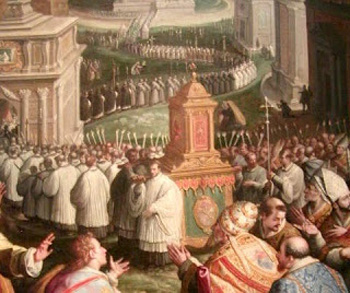
A procession in Rome
Continued
- Francis X Weiser, The Easter Book (San Diego, California: The Firefly Press, 1996), p. 33.
- Dom Prosper Guéranger, The Liturgical Year, vol. IV (Fitzwilliam, New Hampshire, Loreto Publications, 2013) p. 205.
- See sicutincensum.wordpress.com/2019/01/16/voyages-liturgiques-rogation-processions-in-rouen-6/
- Guéranger, The Liturgical Year, vol. V, p. 28.
- https://www.portugalnummapa.com/procissao-dos-sete-passos/
- Rodney Gallop, Portugal: A Book of Folk Ways (Cambridge: University Press, 1961), p. 183.
- William S. Walsh, Curiosities of Popular Customs of Rites, Ceremonies, Observances and Miscellaneous Antiquities (Philadelphia: J. B. Lippincott Company, 1898), p. 616.
- George A. Megas, Greek Calendar Customs (Athens: B. and M. Rhodis, 1963), p. 76.
- Sophie Hodorowicz Knab, Polish Customs, Traditions and Folklore (New York: Hippocrene Books, 1996), p. 83-84.
- T. F. Thiselton-Dyer, British Popular Customs, Present and Past; Illustrating the Social and Domestic Manners of the People (London: George Bell and Sons, 1876), p. 93.

Posted March 1, 2022
______________________
______________________
 |
 |
 |
 |
 |
 |


